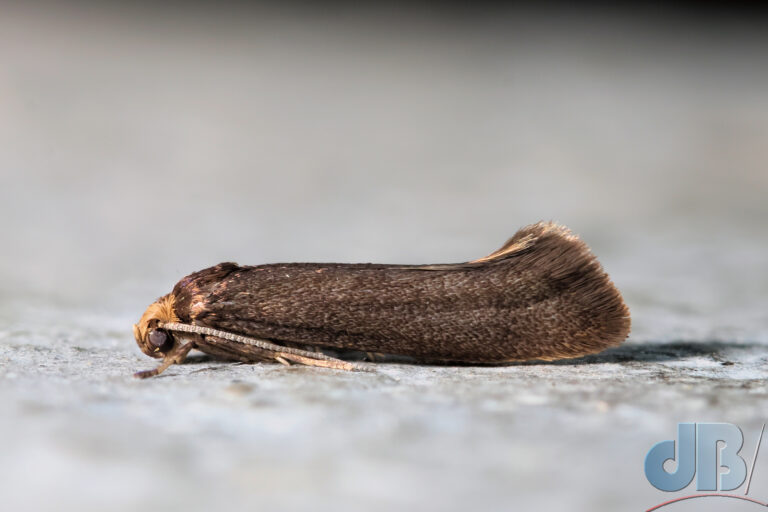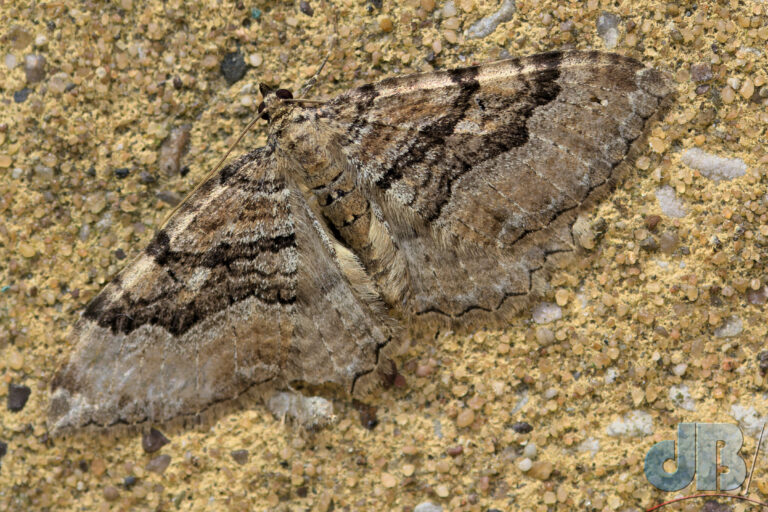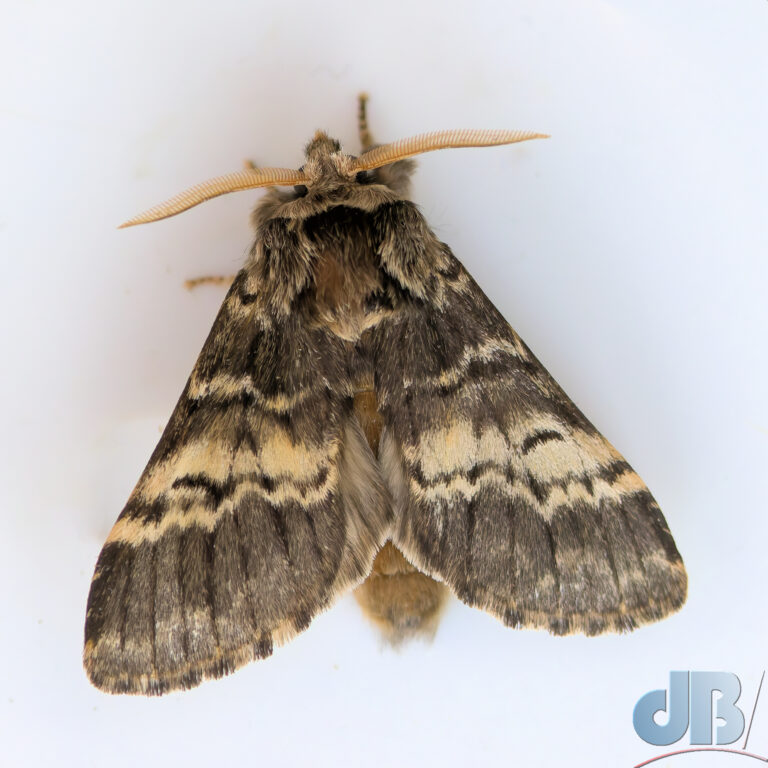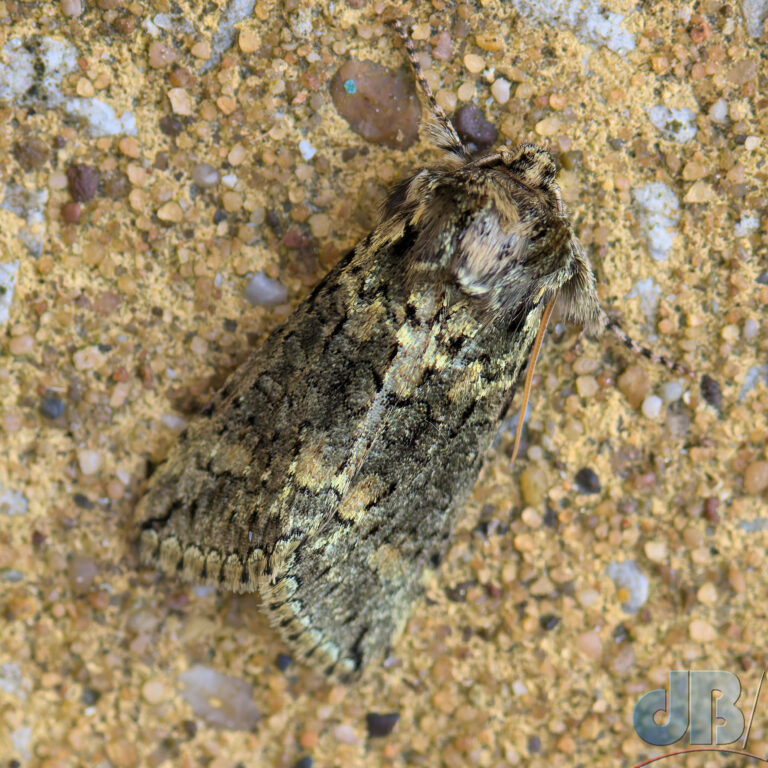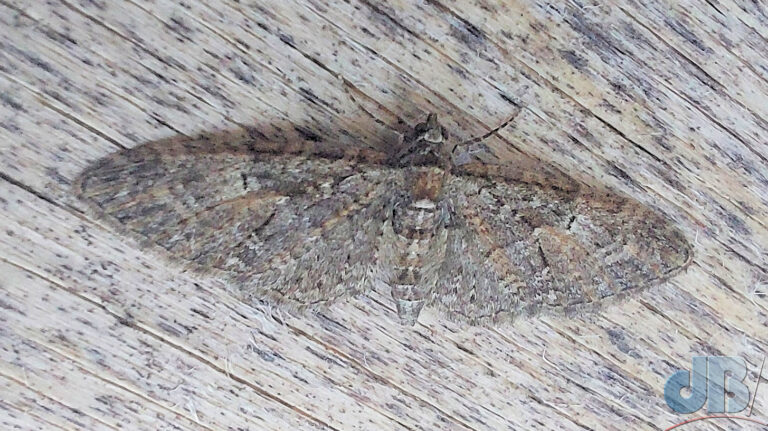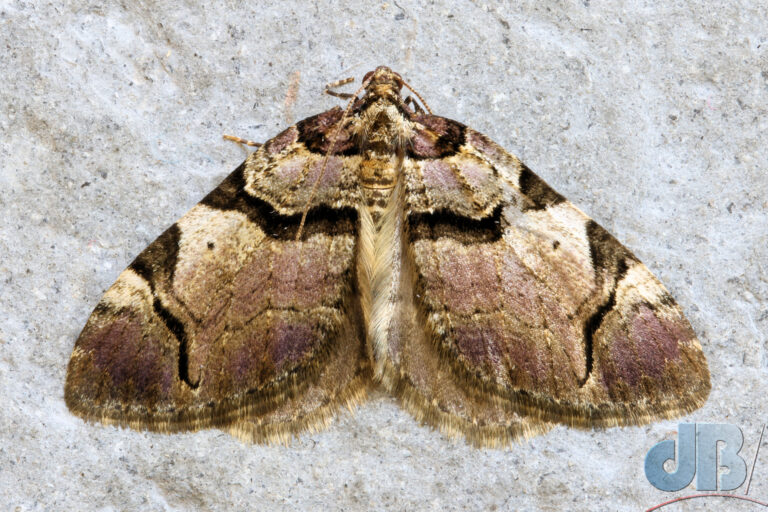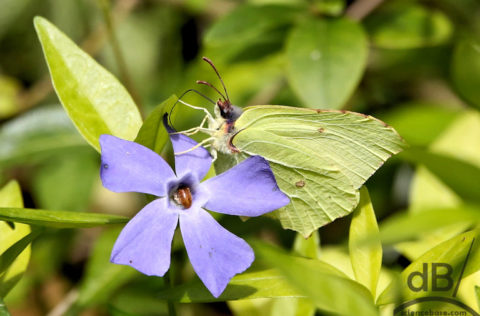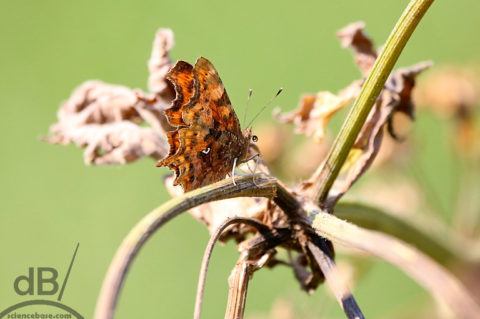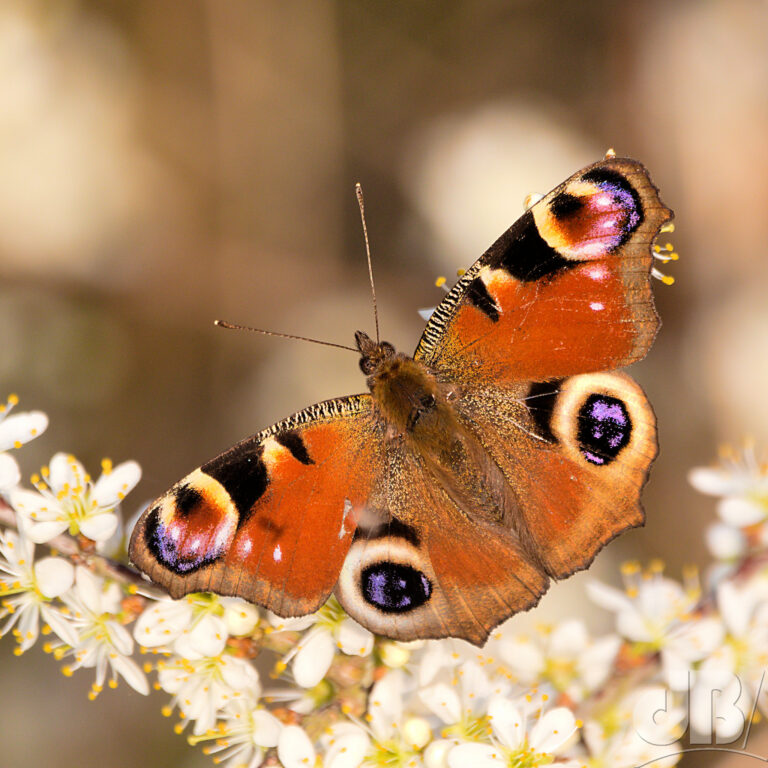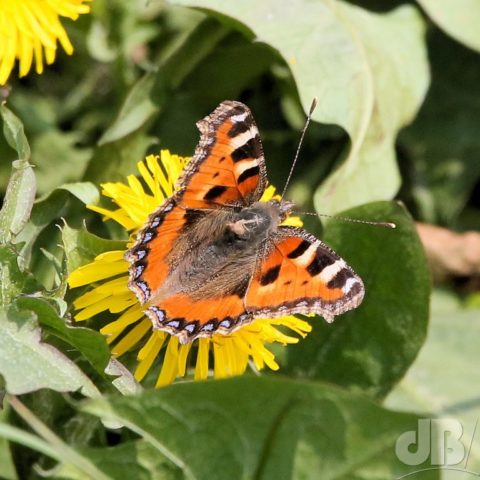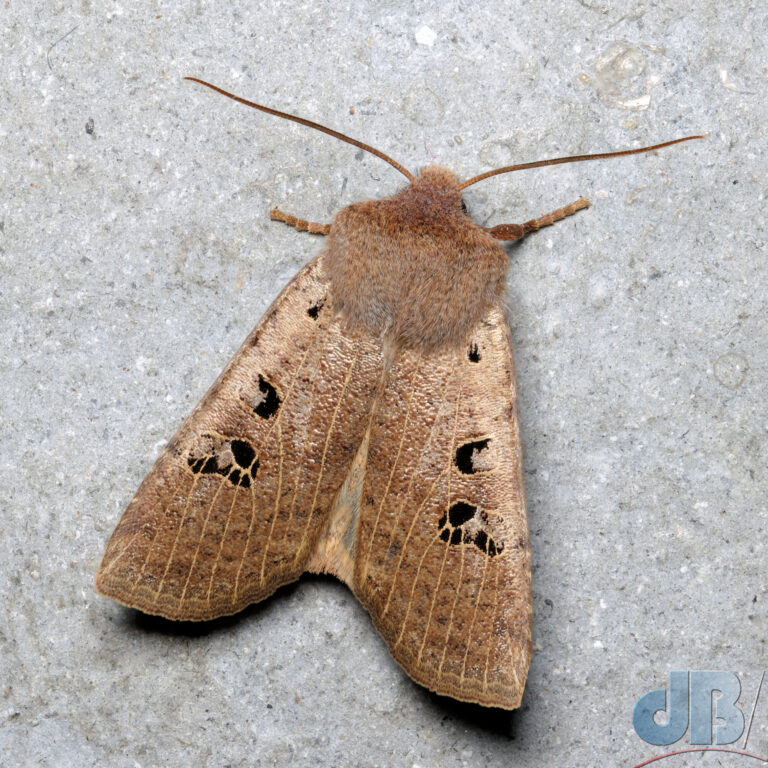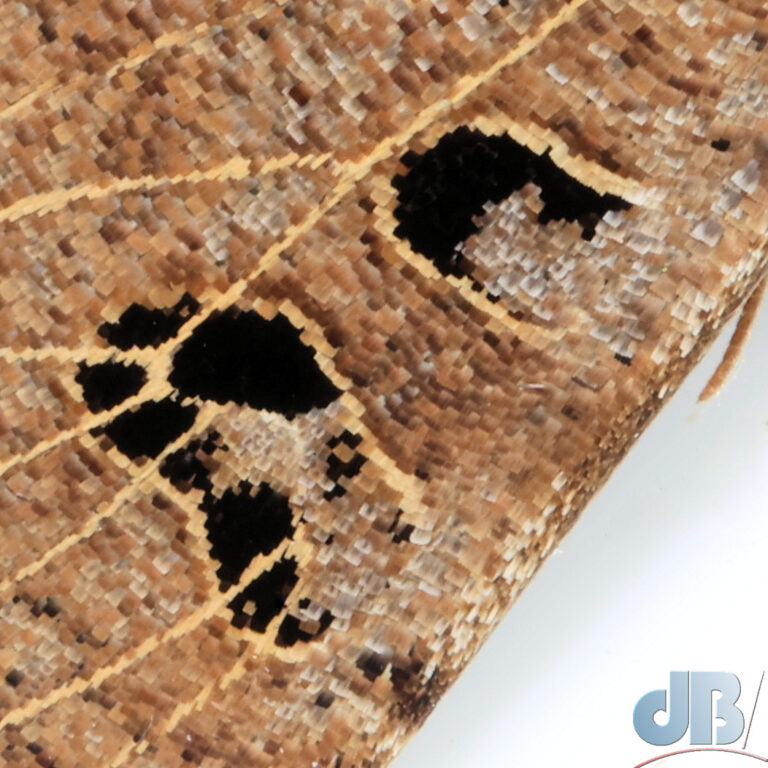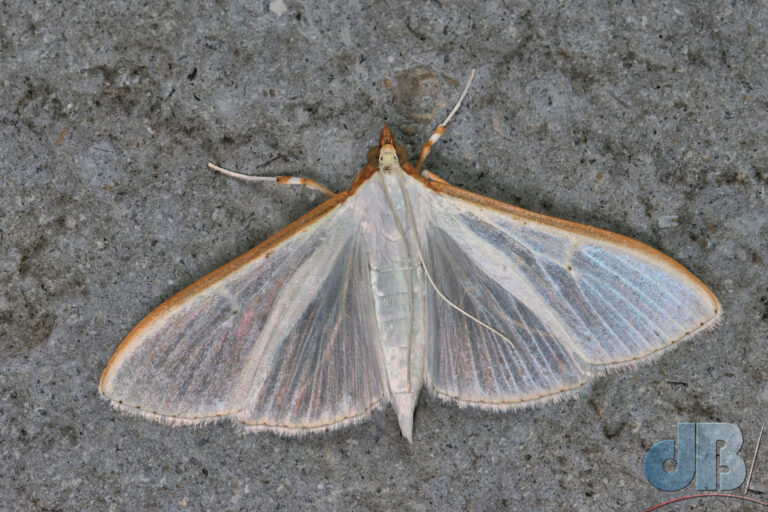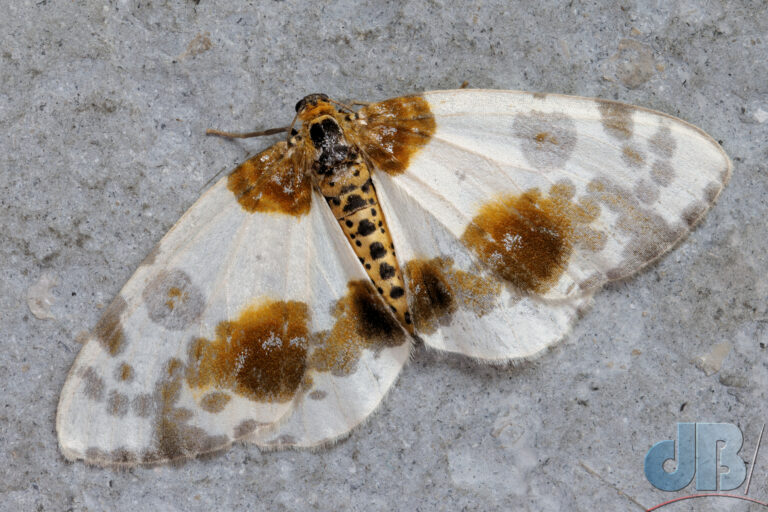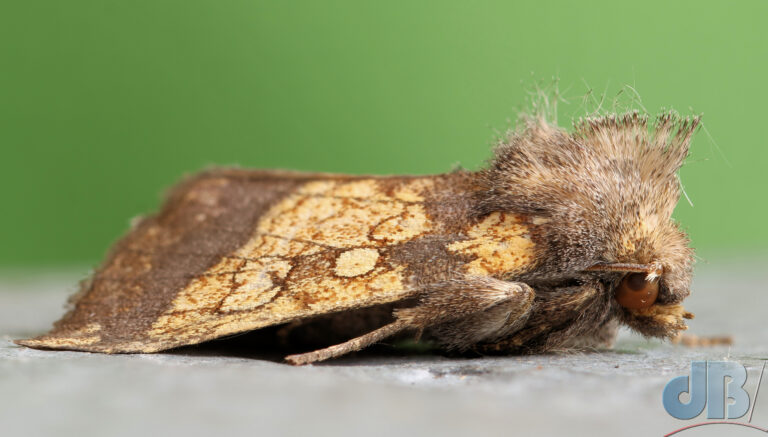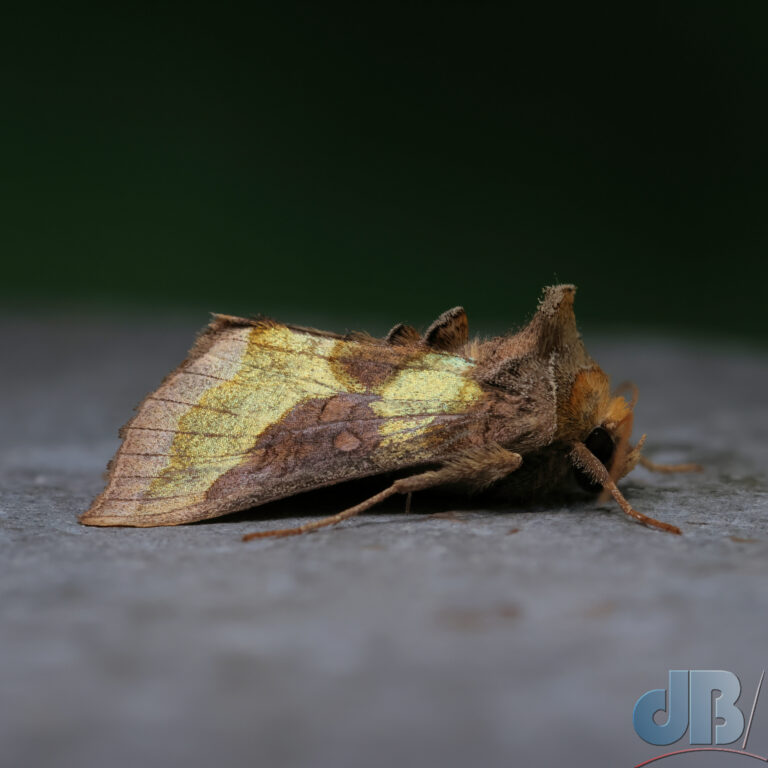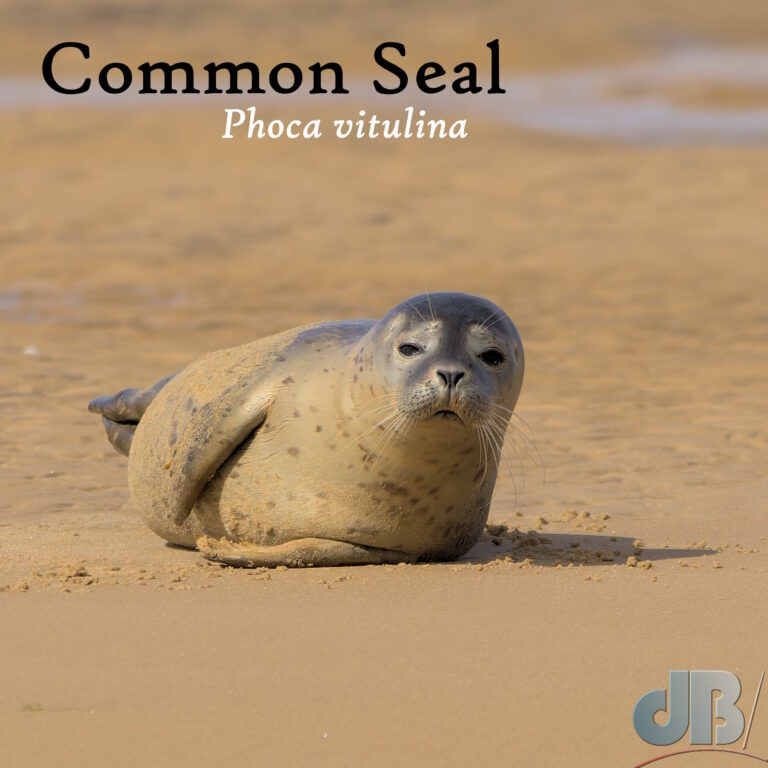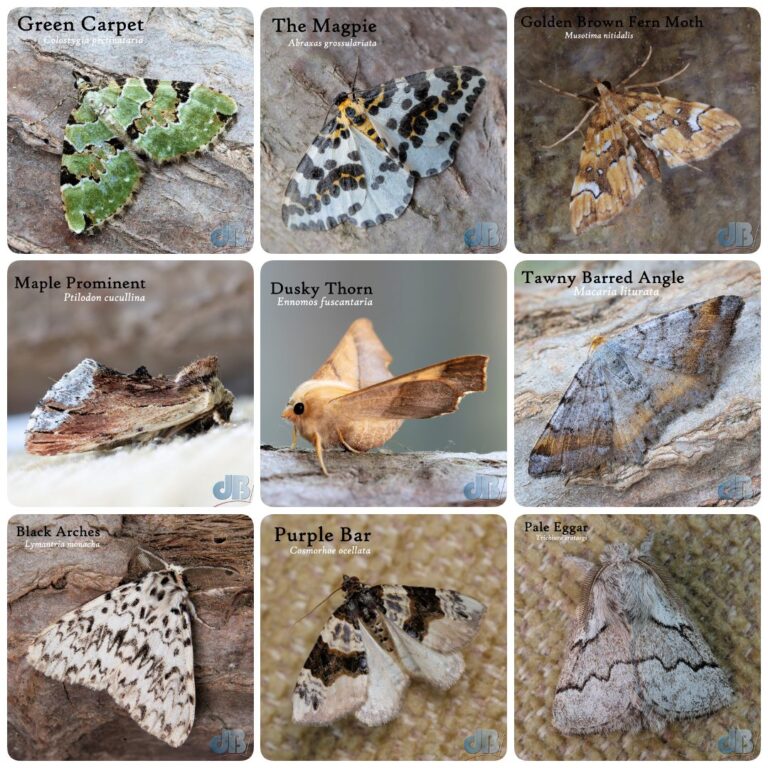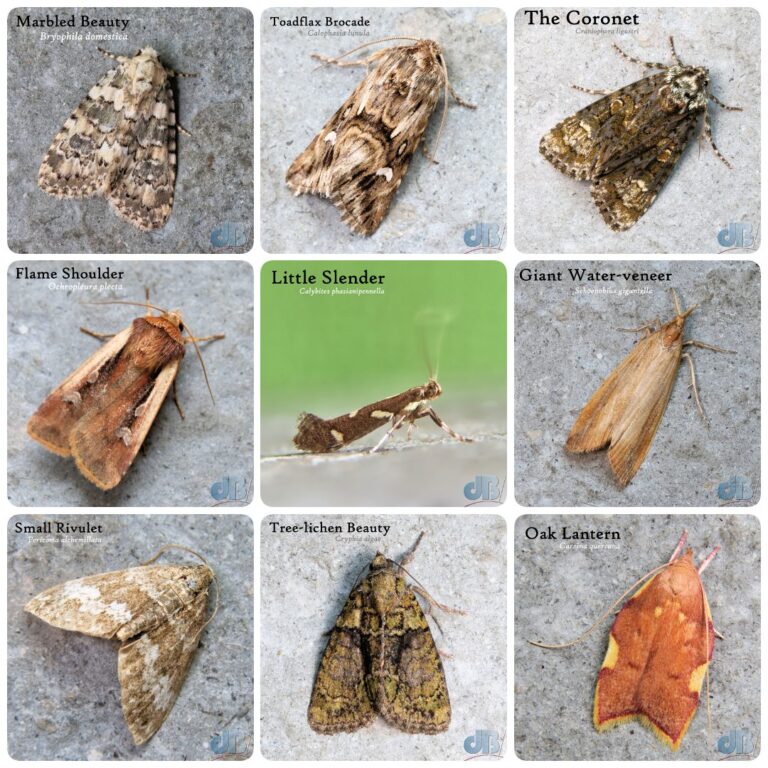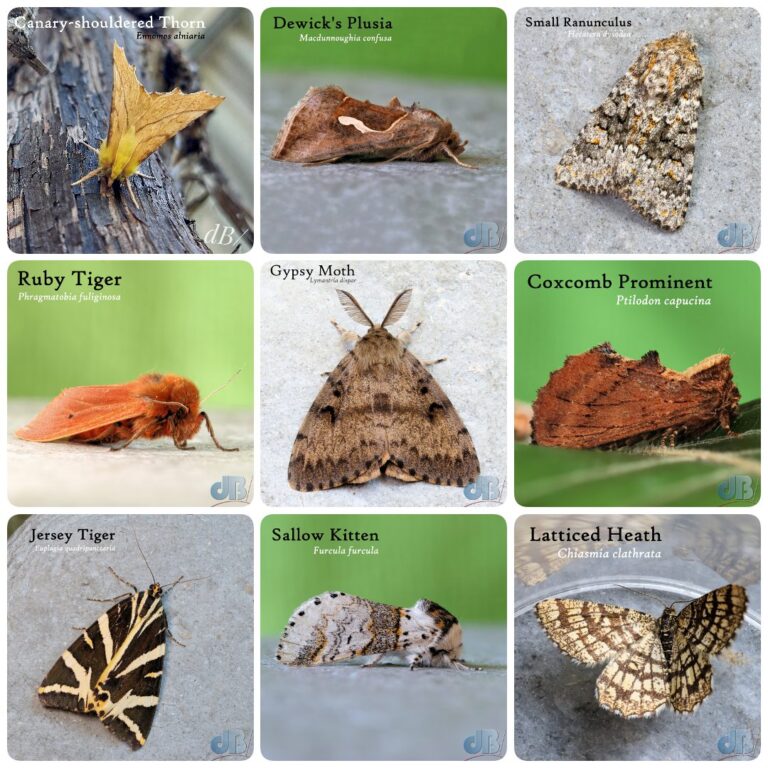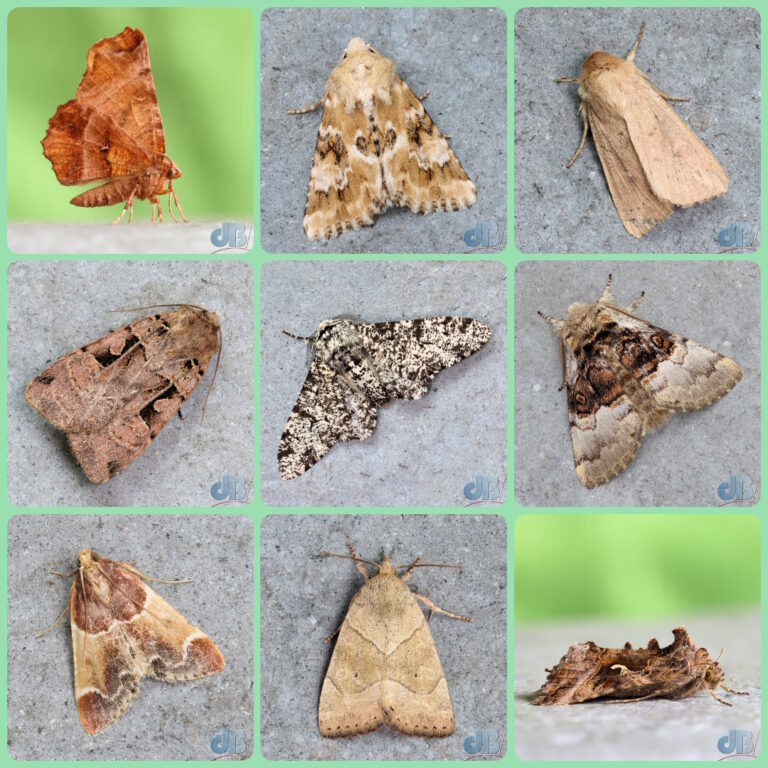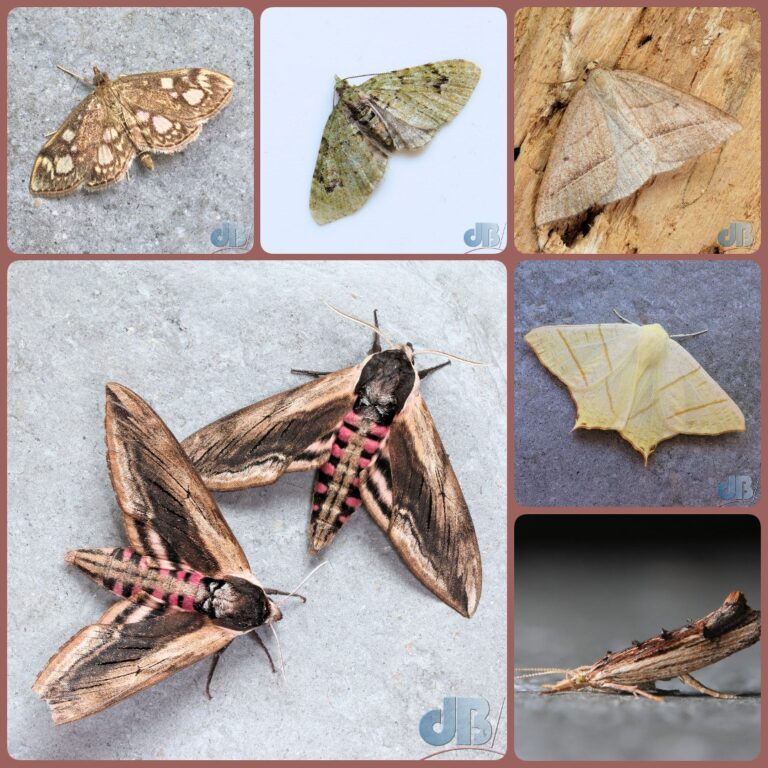A glossary of mothing terms and slang in alphabetical order, for those new to mothing and veterans alike. Italicised terms generally have a definition in the glossary. This, occasionally “proboscis-in-palp”, like my tongue-in-beak birding glossary, is a work-in-progress. Please send me corrections, additions.
Includes booklist, online resources and pheromones.
Abdomen – The posterior part of the body, behind the thorax, carries the digestive and reproductive organs.
Aberration – A deviation from the more common form of a species. Some aberrations have a technical name. For instance, the Jersey Tiger (Euplagia quadripunctaria), which commonly has orange-red hind wings also has a form with yellow hindwings (E. quadripunctaria f. lutescens).
ABH – Modern lepidoptera checklist due to Agassiz, Beavan & Heckford, the official lists of species with currently accepted taxonomic codes and scientific names. It replaces the Bradley & Fletcher (B&F) list.
Actinic – A technical term referring to the ability of a light source to trigger chemical reactions or affect biological systems. Colloquially, moth-ers use it to refer to fluorescent and compact fluorescent tubes that produce ultraviolet light and are used as a lower-power and more accessible alternative to MV lamps. The term synergetic is often to refer to specific types of bulb, but is essentially a synonym.
Adventive – A non-native species found in a new habitat or environment, temporarily naturalized, with potential to become established or not, as the case may be.
Aggregate – A term used in moth recording where a definitive species-level identification is not possible. Usually abbreviated as agg. Perhaps worth noting that in other spheres, such as botany, aggregate/agg. is reserved for species names that include numerous microspecies e.g. Dandelion – Taraxacum officinale agg.
Amyl acetate – A chemical with the odour of pear drops that might be used as an auxiliary attractant. Can be quite harmful to skin, eyes, lungs. Caution required.
Antennae – Sensory organs, usually in pairs on the head. These can be tubular, clubbed, feathery. The antennae can detect smells in the air, pheromones released by the opposite sex, and can also sense air currents. Some antennae are also sensitive to touch. They also serve to help balance the insect in flight.
Apex – The tip of the forewing.
BBYU – Broad-bordered Yellow Underwing (Noctua fimbriata).
Big Blue – See Clif.
Binomen – The two-part scientific name, “Genus species“. Also known as a a scientific binomial and sometimes referred to colloquially as the Latin name.
Bioblitz, moth blitz – An event at which enthusiasts gather at a specific location to collect and document as many species as possible in a short period of time, the latter focusing on moths. Often undertaken on nature reserves or sites of special scientific interest (SSSIs).
Black light – A colloquial term for a UV source. Such sources are used in moth traps but also in food outlet “bugzappers”. They may be coated with purple or dark purple to reduce the emission of visible light. Some decorative black lights do not emit at the wavelengths known to attract insects and so are not generally useful in a moth trap.
Black Underwing – An alternative name for the Old Lady moth, Mormo maura, perhaps due to its size and superficial resemblance to the Catocala underwings. M. maura has also been archaically known as the Grave Brocade, alluding to the sombre clothing worn by 18th Century (not Victorian) widows.
Blank night – Also known as a Wogan or Sir Terry, night when no moths are to be found in or around the trap. The idea of a blank night fills the moth enthusiast with dread. Blank nights are most common between November and April, but can happen at any time of year depending on conditions.
Blue Underwing – See Clif.
Bluey – See Clif.
Bog-mothing – See lavatory
B&F – Bradley/Fletcher checklist, superceded by the ABH checklist.
Buffer – One who indulges in buffing.
Buffing – Northumbrian term describing the placement of moths for images on specially selected twigs, leaves, stones, or other stages.
Butterfly – A sub-group of the Lepidoptera, evolutionarily the most advanced, one might say. Butterflies, with some exceptions lack the frenulum that allows moths to disconnect their forewings from their hindwings. None of the other physical characteristics such as antennae type, wing colours and patterns, silk spinning, whether a species is diurnal or nocturnal are definitive distinctions.
Bycatch – A species that is not the target but is nevertheless attracted to a lure intended for the target species. More generally, non-moth caught in the light trap. See also moth-trap intruder.
Calendar moths – There are several moth species that have the names of the months or seasons – March Moth, Spring Usher, May Highflyer, July Belle, July Highflyer, August Thorn, Summer Fruit Tortrix, September Thorn, Autumnal Moth, Autumnal Green Carpet, Autumnal Rustic, November Moth, Pale November Moth, December Moth, Winter Moth.
Capitals – It is useful to capitalise the common name of a species to avoid ambiguity. E.g. The phrase “Small Yellow Underwing” would refer only to the species Panemeria tenebrata. In contrast, the phrase “small yellow underwing” might refer to either that species or any other yellow underwing that just happens to be smaller than the usual size, for instance.
Carbon dioxide – This non-toxic gas can be dispensed in tiny quantities to temporarily sedate over-active moths for examination or photographing. It might also be used for euthanasis prior to gen det or pinning.
Carpet moths – A reference to species within the Geometridae family that are patterned beautifully in a way that to the early entomologists resembled the then luxury items. These species do not eat carpets. Indeed, there are only a couple of micro moth species the larvae of which can ingest textiles.
Catocala – A genus of large and generally uncommon/localised moth species within the Erebidae family. With wings closed they generally appear similar, mottled grey-brown tree bark. But they share a common feature in having a colourful band across their hindwings. Examples include Clifden Nonpareil (Clif), Red Underwing, Dark Crimson Underwing etc. Sometimes known as “underwing moths“, but not to be confused with the likes of the Large Yellow Underwing.
Checklist – Official lists of species with currently accepted taxonomic codes and scientific names. The modern checklist is due to Agassiz, Beavan & Heckford, often abbreviated as ABH). It replaces the Bradley/Fletcher list.
Chrysalis – The pupa of a butterfly.
Clancy, Sean – Famed for trapping the first UK specimen of Caradrina kadenii, which has the common name Clancy’s Rustic.
Clearwing – General term for a wide variety of day-flying moth species that have largely transparent wings and have evolved more than a passing resemblance to stinging insects such as wasps to reduce the risk of predation. Clearwing pheromones are available to purchase for trapping and monitoring purposes, some are listed at the foot of this page.
Clif – Clifden Non-pareil, Catocala fraxini, large and fairly rare moth, mostly grey upper wings, the hindwings are dark with a chalky blue band. Occasionally referred to as the Big Blue, Bluey, or the Blue Underwing.
Cocoon – A silk casing spun around a pupa for additional protection during this vulnerable transformation stage.
Common names – The macro moths almost always have a vernacular, or common, everyday name. These are less useful internationally and so a scientific name is preferred among lepidopterists to avoid ambiguity. There are only a few formally accepted vernacular names for the many thousands of micro moths, although novel names are being attached to those species.
Confusion species – Any pairs or groups of moth that are so superficially similar that they cannot be identified definitively without either an expert eye, gen det, raising from larvae, or DNA analysis. Examples would include pairs mentioned elsewhere in this glossary, November and Pale November, Dark Dagger and Grey Dagger, and Copper Underwing and Svensson’s Copper Underwing. And, also LBBYU and Langmaid’s Lesser Yellow Underwing. One might also add Hebrew Character and Setaceous Hebrew Character (SHC) as potentially confusing to new mothers. Then there are all the “Minor” moths, the various Rustics and the Uncertain, the many white ermines with black spots (Yponomeuta species).
Connie – Affectionate name for the Convolvulus Hawk-moth.
Copper Underwing – Amphipyra pyramidea, large, brown moth with copper-coloured hindwings, generally has to be aggregated in records unless specific wing features are examined to distinguish it from Svensson’s Copper Underwing (A. berbera).
Coremata – Singular corematum. Protruberant appendages, often furry, signalling structures involved in the dispersal of sex pheromones, for instance. Males can exude pheromones that might act as aphrodisiacs for the female or other chemicals that might tranquilize her. See also hair pencil, which is usually a fluffy end to the male abdome in some moths with a closely related function. Famously male Creatonotos gangis, Baphomet Moth, have large -tentacle-like coremata, which perhaps help give rise to its other vernacular name, the Australian Horror Moth.
Costa, or costal margin – The leading edge of the forewings or hindwings closest to the moth’s head.
County Moth Recorder, CMR – Your local moth expert who will collate, check, and maintain records for the vice county. Often sufficiently skilled to carry out gen det.
Darth Vader – It’s a toss up as to wheher this epithet refers to the December Moth (Poecilocampa populi) or the Black Rustic (Aporophyla nigra). Both are on the dark side, as it were, but the December looks like it has a string of fairy lights whereas the Rustic is very much the goth moth with the creamy satin undersheets.
Ditrysian – The females of some Lepidoptera have two sexual openings, one for insemination by the male and a second for oviposition, egg laying.
Dusking – A term mentioned in an article by Peter Marren on mothing through the ages, the activity involves wafting a net or waving a stick about grasses and bushes on a balmy summer’s evening in the hope of spotting crepuscular Lepidoptera.
Egg cartons, trays – Perhaps the least technological, and yet essential, component of one’s moth trap. Cardboard egg trays providing roosting sites for the moths that enter your trap. They also offer an easy way to lift out the catch in stages for examination, potting, photography etc. There is a lot of advice on how best to arrange egg cartons and the size to use. Lots of small trays or large trays cut up and arranged with some space between them will create a large surface area within the trap.
EHM – Elephant Hawk-moth (Deilephila elpenor)
EMP – Sex pheromone sold as an attractant for male Emperor, Saturnia pavonia. I discussed the Emperor moth and the chemistry of its sex pheromone elsewhere on Sciencebase, so felt it needs a standalone entry.
Endotricha flammealis – A distinctive micro moth that roosts in a stilted posture. Given the nickname Flaming Alice by Les Evans-Hill in 2003. A more common vernacular name is the Rose-flounced Tabby, or Rosy Tabby.
Entomology – The branch of the zoological sciences that deals with insects. A lepidopterist is an entomologist who specialises in Lepitoptera.
Ermine moths – Commonly used to refer to the Yponomeutidae.
Extant – A living species, the opposite of extinct.
Extinct – It has ceased to be, when referring to a species. The opposite of extant.
Extirpated – A species lost to a particular region, not globally extinct, still extant in some places.
Eyespots – Wing markings that give the appearance of eyes staring back at a would-be moth predator. Famously, the Emperor has two pairs, one pair on its forewings which are visible when the moth is at rest and a second on its hindwings which can be exposed when it is disturbed. They are sometimes referred to as ocelli, but not to be confused with the simple, sensory, eyes that many invertebrates, including some larvae and adult Lepidoptera have.
Field guide – A reference book, usually illustrated, which describes the species one might find in a given region. A comprehensive guide will cover appearance, lifecycle, behaviour, larval food plants etc.
Flight period – The weeks or months in which the adult moths are on the wing, feeding, and seeking a mate.
Flutters – Affectionate term for moths.
Flying tonight – A phrase often used by moth-ers when discussing the likely species one might see on a given night of the year.
Food plant – The plant species on which a particular larva will feed. The larvae of some species of moth can eat various plants, they are polyphagous, but some have a single food plant.
Forewings – The pair of wings attached on the thorax closest to the moth’s head.
Frankentrap – a homemade or altered moth trap, not always the most aesthetically pleasing construction.
Frass – Usually, larval faeces, but more generally any detritus left behind by insects.
Fremissing – A provisional term coined to describe the rapid oscillation of forewings that will allow a moth to warm itself ahead of flight. From the French verb frémir, meaning to quiver or tremble. See also shimmering.
Frenulum – An anatomical feature present in the majority of moths, but not those Lepidoptera we refer to as butterflies. There are some exceptions and anatomical differences. The frenulum connects the forewings and the hindwings in moths, but can be “unhooked” so that a moth can flap its forewings separately from its hindwings. This is a common mechanism employed by moths to warm up, just as mammals will shiver. Butterflies generally cannot do this and rely on heat from the sun to warm themselves.
Fresh – A newly emerged adult moth, one that has not yet lost scales nor been bitten and battered. The opposite of worn.
Fridge-ticker – A usually derogatory term used to describe a moth twitcher. One who rushes to see a moth trapped, potted and put in the fridge, by someone else at a location other than the fridge-ticker’s own trapping site(s).
Fridge ticking – The act of requesting or being openly invited on social media or through other channels, to view a live, captive moth, generally retained in the captor’s refrigerator at home for the specific purpose of adding a rare species to a personal list.
Fridging – To put an excitable moth in the refrigerator to cool or chill down so that it might be examined or photographed more easily. Not to be confused with fridge ticking, although fridging may well be involved in the latter.
Fringe – Tiny hair-like structures along the outer margin of the moth’s wings, which may help with flight or provide camouflage.
Full Moon – Often assumed to be the guilty party for a poor night’s trapping on a clear night, but not necessarily so.
Furniture polish and cloth – Useful tools for cleaning frass, avian guano, and other muck from components of the trap such as the Robinson trap vanes and funnel, rainguards, Skinner trap Perspex panels etc. It might only make a little difference but a moth landing on a smooth, clean surface is likely to get less grip than on a dirty trap funnel, panel, or other part and so end up sliding down into the trap and among the egg cartons.
Garden list – A record of moth species recorded in and around one’s home.
Gen Det – An abbreviation for genitalia determination. This is the definitive method of species-level identification where two species are superficially the same. Given that the genitalia of each species are unique to that species, microscopic examination or dissection can reveal the specific ID. For instance, without gen det or having raised adults from larvae it is impossible to distinguish between Dark Dagger (Acronicta tridens) and Grey Dagger (Acronicta psi). Where no distinction is made, recording the sighting would usually be listed as Dagger “agg.“, or “aggregated“. One might also write “Dagger sp.” where sp. is an abbreviation for “species” and implies the same as “agg”.
Genus – The taxonomic classification of living things above species and below family level. For example, the Hummingbird Hawk-moth is Macroglossum stellatarum, it is the species stellatarum in the genus Macroglossum. The family to which it belongs is the Sphingidae, the sphinx moths, which is one of the many families in the order of insects known as the Lepidoptera.
Geoff – An informal nickname for the lovely micro moth with the scientific name Alabonia geoffrella. iNaturalist gives its common name as Common Tubic.
Geometridae – The geometer moths, also known as looper moths. Known in the US as inchworms because of the way in which their larvae move, as if measuring out the earth (geo, meter). Includes the carpet moths and many other species.
Ghost trap – Related to a blank night but the lack of moths in one’s trap is due to a feeding bird having picked off all your flutters before you got your lazy backside out of bed.
Gossyplure – A chemical used commercially to reduce infestation of cotton by species such as Pink Bollworm, Pectinophora gossypiella. Hexadeca-7,11-dienyl acetate.
Grip – To brag openly, but hopefully light-heartedly, about a particular catch, especially when one knows that those to which one is bragging have so far failed to trap said species. Thanks to Alan Salter for this word.
Hair pencil – Commonly a furry end to the male abdomen in various species, such as Box-tree Moth. Males can exude pheromones that might act as aphrodisiacs for the female or other chemicals that might tranquilize her. The hair pencil helps disperse these chemicals. See also coremata.
Have a look at, take a look at, try looking at – When someone asks for an ID for what may well be a well-known moth, old-timers will often be gentle in their answer to suggest that the newbie looks up the species they suggest, rather than simply giving them the ID bluntly.
Hawk-moth – Any of numerous species of large moth sharing various characteristics but not necessarily genus. They are grouped as the family Sphingidae family, which means Sphinx Moths. They commonly have “hawk-like” features and can hover. The “hawk” in question when they were given this epithet was perhaps the kestrel, a falcon, rather than any hawk. Often abbreviated in one’s records as HM, as in Privet HM, Convolvulus HM, etc.
Heath trap – A portable, and usually collapsible, version of the Robinson trap. Developed by entomologist the late John Heath, chief editor of MBGBI.
Hindwings – The pair of wings attached on the thorax furthest from the moth’s head.
Honeysuckle – Any species of Lonicera, the sweet, nocturnal scent of which is often attractive to hummers.
Hummer – Hummingbird Hawk-moth (Macroglossum stellatarum). A migrant species that seems increasingly common in the UK. Not to be confused with US species known as hummingbird moths.
Ichneumon Wasps – Also known as Darwin Wasps, there are numerous species of these parasitoid wasps in the Ichneumon genus. They commonly seek out invertebrates and lay their eggs in the animal or its larvae. It is not common to find them in one’s moth trap.
ID – Identification.
Imago – Adult form of an invertebrate.
Inchworm – The US term for the geometer moths, and specifically their larvae. Describes how the movement of the larvae is suggestive of the larvae measuring (meter) the earth (geo).
Inner margin – The edge of the wing closest to the moth’s body, often where the wing folds during rest.
Instar – A stage in the maturation of a larva from hatching to pupation.
Invasive species – Usually refers to an unwanted migrant or import that has appeared in relatively large numbers and is causing harm to native ecosystems, crops, or other managed plants. The Box-tree Moth (Cydalima perspectalis) is perhaps one of the most well-known of the invasive moth species.
Iridescence – The generation of different colours through reflection and refraction of light. In the Lepidoptera, it is the scales that can produce colouration on the insect’s wings rather than the presence of coloured pigments. Although in some cases underlying pigments may augment the patterning and colours.
Irruption – The arrival in relatively large numbers of a species not commonly seen in a given region or country. Commonly migrants or vagrants.
JRL – Familiar name for the late John Rendle Langmaid.
Kidney mark – Often species specific, diagnostic, “kidney-shaped”, or reniform, marking on the forewing. One of various marks known as stigmata.
Langmaid, John Rendle – Retired family doctor and amateur lepidopterist known familiarly as JRL. Well-known as having authored several of the beloved moth books and famed for his leafminer hunts. His name is immortalised in the vernacular name of Noctua janthina, known as Langmaid’s Yellow Underwing, it having been distinguished from N. janthe, Lesser Broad-bordered Yellow Underwing in 1991. The two species are still considered confusion species as a definitive ID requires an expert eye and examination of the colouration extent of the hindwings.
Larva – The technical term for the juvenile stages of Lepidoptera, colloquially, caterpillars.
Larval nest – Several types of moth larvae will feed in groups and some will spin protective enclosure around themselves on their food plant.
Lavatory – Usually referring to a toilet with open windows or door that remains illuminated overnight, where a mother requiring use of said facilities in the morning might see numerous moths roosting in and around the building. Public conveniences and campsite toilet and washing blocks are prime targets for lavatory-mothing (loo-mothing, lavvy-mothing, toilet-mothing, bog-mothing). Care should be taken to act as normal as possible in obtaining a toilet ticklist. Potting and photography are not advised in busy premises.
LBAM – Light-brown Apple Moth (Epiphyas postvittana). A variable species originally seen only in Australia.
LBBYU – Lesser broad-bordered Yellow Underwing (Noctua janthe).
Leafminer – Any of numerous species the larvae of which secrete themselves within a leaf and consume the leaf, usually leaving a trail, or mine, behind them, before pupating.
Leafminer hunt – Mothing activity involving seeking out the larvae through identification of their trails in leaves. Famed leafminer extraordinaire is the late JRL.
LED – Light-emitting diode. UV lamps that use these low-power devices are becoming increasingly common. There are various options readily available, such as adhesive strips of UV LEDs, but also sophisticated gadgets such as the LepiLED.
Lemp, lämp – Subject of a rather surreal internet meme that went viral around September 2018. The memes hilariously lampooned the notion that moths are obsessed with lemps (lamps). Commonly, the meme featured a closeup photo of a moth, perhaps with eyes glowing in the lamplight or from photograph flash, with the hilarious accompanying caption rendered in the style of countless other equally hilarious memes, such as the famous “I can has cheezburger” meme.
Lepidoptera – Any of the 180000 or so invertebrates we refer to as moths and butterflies. The word comes from the Greek meaning “scaly wings”, or in some sense “tiled wings”. The Lepidoptera is the second largest family of insects in the world, after the beetles, the Coleoptera (400000 species described), the term means sheathed wings.
Lepidopterist – A scientists specialising in the Lepidoptera.
Leps – Moths, colloquially moffs.
Life list – A record of all the moths one has ticked in one’s life.
Lifer – A moth seen for the first time by a moth-er and added to their life list.
Linnaeus, Carl – Pioneering 18th Century Swedish taxonomist, also known as Carl von Linné, who catalogued and named species and is often referred to as the father of taxonomy. Linnaeus devised the scientific binomial system of nomenclature, often referred to colliquially as the Latin name of a species. A full species name will include the scientific binomial and the official cataloguer. E.g. Catocala fraxini (Linnaeus, 1758), the Clifden Nonpareil or Clif.
Little Nelly – Whimsical nickname for Deilephila porcellus, Small Elephant Hawk-moth, see also Nelly.
Local patch – One’s immediate environs in which need travel only a short distance to built a patch list. Usually includes one’s garden where the trap might be employed most commonly, but also local areas where one might make a field trip.
Logger – Any large moth that has made it into the house, possible Geordie vernacular.
Macro moth – A term once used to allude to the relatively large size of various species, however, it now refers to the evolutionary position of the species with the macro moths being more advanced among the Lepidoptera than the micro moths. There are several macro moths that are much smaller than some of the micro moths.
Mega – A moth very rarely, if ever seen on a given patch, one that will be a lifer for almost everyone on the patch who sees it.
Merv, or Marv – Merveille du Jour, sometimes MdJ, a beautiful, largely green and black winter moth, often referred to as the Wonder of the Day, although Marvel of the Day would be more fitting.
Micro moth – A term once used to allude to the relatively small size of various species, however, it now refers to the evolutionary position of the species with the micro moths being closer to the common ancestor of Lepidoptera than the macro moths. There are numerous micro moths that are much bigger than many of the macro moths.
Migrant, immigrant – Species of Lepidoptera that are not native to a given country but arrive when conditions are suitable or are carried on a wind to another region. Migrants and immigrants may be common in a given year. Vagrants are migrants seen less commonly, perhaps a one-off appearance.
Mods – DIY modifications made to one’s trap, such as adding baffles to a Skinner trap to improve retention, doubling up on lamps etc.
Monotrysian – The females of some Lepidoptera have a single sexual opening, for both insemination by the male and for oviposition, egg laying.
Moth – Any of the Lepidoptera. Insects with two pairs of scale-covered wings.
Moth-er, mother, moth-trapper – Someone with more than a passing interest in observing moths, usually the owner of a moth trap or other equipment such as lures and lots of books about moths. Akin to being a birder. Commonly there is a degree of obsession or even addiction.
Moth gods – According to David Wheatley, an evil and vindictive bunch of deities, that play with the lives of moth-ers like pieces on a chessboard. Moth trappers pray to them for rarities and blame them for misfortune and bad luck.
Mothing – Activities commonly associated with being a moth-er. Akin to birding. Commonly, the activity becomes an obsession or even an addiction for mothers.
Mothery – All things moth. Word coined by Dave Wheatley.
Moth Night – Not dissimilar to a Bioblitz, or Moth Blitz, wherein an individual or team dedicates a night to observing and identifying moths. There is a formal Moth Night organised by Atropos.
Moth trap – One of various open-ended containers into which one might entice moths for subsequent observation and recording.
Moth-trap intruder – Species other than Lepidoptera that might be found in one’s trap including Ichneumon wasps, spiders, ladybirds, ants, beetles, amphibians, even birds.
MothsMatter – Common hashtag on social media among moth-ers, a call to arms.
MV lamp – Mercury Vapour lamp. Powerful ultraviolet lamp known to attract large numbers of many species of moth. Once common these high-tensity, high-wattage bulbs are no longer for sale legally in the EU. They get very hot and are easily damaged by rain. UV safety goggles are essential when using an MV lamp, but it is advisable not to stare at such lamps.
National Moth Recording Scheme (NMRS) – Launched in 2007 to collate current and historical sightings of moths. Data are used for various scientific purposes and fed into the Atlas of the Britain and Ireland’s Larger Moths, mentioned in this glossary.
Nelly – Whimsical nickname for Deilephila elpenor, the Elephant Hawk-moth. See also Little Nelly.
Netting – The action of using a net, usually with a handle, telescopic or otherwise, to catch flying insects. It may also be used to sweep through grass and other vegetation to catch insects resting or feeding on said vegetation for examination and subsequent release.
NFG – New for garden. Also NFY, new for year, NFS, new for site, NFM, new for me (lifer). Ben Sale suggests he coined these abbreviations in 2006.
Nicotiana – Sweet-smelling tobacco plants the scent of which is strongest at night, often favoured by Connie.
Noctuid – One of the owlet moths, members of the Noctuidae family.
Numbers – When reporting one’s trap finds, moth-ers will often cite a pair of numbers. 86/23, for example. Or, they might say 86 of 23. This would commonly refer to the number of specimens (the larger number) followed by the number of species. So 86 moth speciments of 23 species.
ObsIdentify – Useful website and app for species identification. Be cautious, apply Occam’s Razor when using this or any other nature ID apps. I’d suggest it is best to learn your moths using the books and perhaps checking with Sean Foote or other experts if you’re not 100% sure. The apps can give you more than a hint if you’re completely stuck, but as with all such AI tools, they can be prone to false positives.
Occam’s razor – A useful tool for novice moth-ers to use when reporting a sighting of a rare species that looks very like another species. Occam’s razor suggests that the simpler explanation is more likely than the exceptional. For instance, that Speckled Yellow on the north Norfolk coast in late August was most likely not a Speckled Yellow, but perhaps a Yellow Shell, given that the Speckled Yellow is confined to The Brecks and its flight season ends in late July. Honest mistakes are not to be confused with deliberate stringing.
Orbicular stigmata – The orbicular stigmata are the round, almost heart-shaped, markings on the wings of noctuid moths. As opposed to the kidney-shaped reniform stigmata.
OTSJ – Over-the-shoulder-job. A moth too worn or toow difficult to be identified.
Oviposition – Egg laying.
Owlet – One of the noctuid moths, members of the Noctuidae family.
Palps – Usually protruberant anatomy on or close to the mouth used in sensation and feeding.
Pheromone – A chemical released to influence the behaviour or physiology of others of the same species. Most commonly in the Lepidoptera as sex pheromones released by females to attract males. Famously, the male Emperor moth can detect female sex pheromone with its antennae from as far as 16 kilometres away. Lists of pheromones that can be used to lure species are given below. Some pheromones will attract non-target species, bycatch.
Pheromone trap – Usually a small, cylindrical trap with a funnel-shaped opening into a vessel. Above the funnel is a basket into which a rubber bung infused with a sex pheromone for the target species will be placed. Commonly used during the day to entice and trap various clearwing moth species, Emperor moth, Gypsy Moth, and others. Similar traps are often used by non-mothers in a vain effort to protect garden plants, such as box hedges from invasive “pest” species.
Pinacolada moth – Another delightful micro, Rhyacionia pinicolana, Orange-spotted Shoot.
Pinning – The once common, but now generally frowned upon, process of laying out a deceased moth for display. That said, it is still used by some amateurs and professionals for various purposes. Many natural history museums and galleries hold countless pinned specimens of Lepidoptera.
Playboy Bunny moth – Ypsolopha sequella, the Pied Smudge. This two-tone, black and white moth has patterning that resembles the rabbit ears logo of the Playboy brand, hence its colloquial name.
Pooter – A jar used to collect insects. It commonly has two tubes, one of which is protected by a gauze, which can be used to apply suction so that an insect is drawn into the jar through the second tube.
Positive ID – Definitive identification of a species based on appearance and perhaps gen det or it having been raised from known eggs/larvae.
Potting – To enclose a moth from the trap, washing line, or elsewhere, in a suitable, usually transparent, container, or pot, for easier examination, or for fridging.
Proboscis – Insect “tongue”. In Lepidoptera it is usually a bifurcated feeding tube that can be coiled up, hose-like, below the palps when not in use.
Pseudopupil – The lepidoptera, like many invertebrates, have compound eyes. One can usually see a dark spot when looking at their eyes that seems to move as viewing angle changes as if the eyes were following you. This is not the case. The eye units, ommatidia, directly facing the observer appear to absorb light and so look dark, whereas those at other angles reflect light, so that the pseudopupil simply reveals eye units the viewer is aligned with.
Puddling – Behaviour where lepidoptera might gather on moist soil, mud, puddles, wet or sappy wood, rotting fruit, or even faeces to drink water and extract minerals .
Pupa – The lifecycle stage between larva (caterpillar) and imago (adult).
Rain – Not what MV lamp users want to see in the forecast as there’s an increased risk of a shattered bulb. However, warm, yet runny summer nights often bring decent numbers and diversity and occasionally a mega or a migrant.
RDP – Rusty Dot Pearl, Udea ferrugalis, a migrant species to the UK that can appear almost any time of year.
Reniform stigmata – The reniform stigmata are the kidney-shaped markings on the wings of noctuid moths. As opposed to the more round, heart-shaped orbicular stigmata.
Retaining – The act of keeping a given specimen for gen det or other purposes. Usually, reserved for rare or vagrant species for which one has only an ambiguous ID.
Resident – Species that remains in its native territory throughout its lifecycle and does not migrate.
Rhubarb & Custard – A nickname for the micro moth Oncocera semirubella alluding to its colouration.
Robinson trap – Usually a large bucket-shaped or box-like structure with a hole in the top into which a snug-fitting funnel is sited. The lamp, usually a high-intensity ultraviolet-emitting, mercury vapour lamp, is suspended above the funnel. Some designs will have vertical panels, vanes, that incoming moths may collide with and so drop down into the funnel and into the box. The box will be filled with egg cartons or trays to provide dark roosting sites where they will settle until one examines the trap contents at first light. Invented in 1950. Named for its inventors H.S. Robinson and P.J.M. Robinson.
Rothamsted Insect Survey (RIS) – An ongoing insect survey consisting of a national network of suction (for aphids) and light traps (for moths). There are 80 RIS light traps across the UK and Ireland. Most of the light traps are emptied daily. Together they have recorded 1500 species of, mostly, macro moths.
Rothamsted light trap – Specialist light trap invented in 1948 and used in the RIS since the 1960s. It uses a 200-Watt clear tungsten-filament bulb.
Sallowing – A term mentioned by Peter Marren in an article on the history of mothing that refers to examining the catkins of sallows and related species for moths drunk on the semi-fermented nectar. Often involves laying a sheet below a tree and shaking or beating branches to loosen moths.
Scales – Modified, flattened, hairs that cover the wings and bodies of the Lepidoptera. The scales give butterflies and moths their wide variety of colours and patterns. Colouration can be due to the presence of pigments or produced through iridescence.
Scientific name, scientific binomial, Latin name – The technical, and usually unique name for a species. The first part of the binomial refers to the genus the second part the species, if there is a third part this usually refers to a sub-species. The name may have an additional descriptor to refer to an aberration. In a document that mentions more than one species from a single genus, commonly, the first mention gives the full name and thereafter the genus is abbreviated. E.g. in discussing the Copper Underwing and Svensson’s Copper Underwing one would write Amphipyra pyramidea and A. berbera. Scientific names should be italicised in printed text and perhaps underlined in formal, handwritten documents.
Second brood – Some moth species breed early in the season and their offspring have a chance to breed later in the summer. So they are double-brooded, or bivoltine.
SHC – Setaceous Hebrew Character (Xestia c-nigrum). Setaceous means bristly, the “hebrew character” of its name refers to a marking on the forewing thought to resemble the Hebrew letter nun. For that latter point there is also a species that appears earlier in the season, Hebrew Character (Orthosia gothica).
Shimmering – A provisional term coined to describe the rapid oscillation of forewings that will allow a moth to warm itself ahead of flight, alluding to the speed of this activity and its impact on our view of the moth. See also fremissing.
Sir Terry – A Wogan, a blank, as in 1970s TV British quiz show, Blankety Blank, originally hosted by our hair-lacquered hero.
Skinner trap – Usually a large box-like structure with an open top. Two snug-fitting panels are held in place to form a V shape in profile with a narrow slot. The lamp is suspended above the funnel. Incoming moths will fly into the gap between the panels and hopefully then roost among egg cartons or trays within until one examines the trap contents at first light. Named for its inventor, Bernard Skinner, author of the classi field guide, Moths of the British Isles, see booklist.
Skunk work – Secret mothing, mothing done under the radar, usually referring to an activity of which ones partners knows nothing.
Soda Stream – A device commonly used to infuse carbon dioxide gas into water for drinking, which might be adapted by a moth-er for the purposes of temporary moth sedation, or permanent euthanasia. See also Sparklets Corkmaster.
Sparklets Corkmaster – A gadget originally designed to inject a small amount of carbon dioxide gas through a wine cork into a bottle of non-fizzy wine to assist in the removal of said cork. Might be adapted by a moth-er for the purposes of temporary moth sedation, or permanent euthanasia. See also Soda Stream.
Species – A term commonly used to refer to moths that are physiologically the same in terms of appearance, behaviour, biology, and genetics. They can breed and produce fertile offspring.
Species, Sub – A population of a species that exists in a different area and might vary in physical characteristics (morphology), but can nevertheless breed with members of any other populations.
Sphinx Moths – The US term for the Sphingidae, or Hawk-moth, family of moths.
Spongy Moth – The new politically correct US name for Limantria dispar, which is still commonly known in the UK as the Gypsy Moth.
SSD – Shuttle-shaped Dart (Agrotis puta).
Stage – An artificial setting (twigs, plants, stones) for posing a moth for photographic or other artistic purposes.
Stigmata – Distinctive markings on the forewings of many species of moth that can guide identification. The orbicular stigma is a small, often circular spot found toward the middle of the forewing. The reniform stigma, or kidney mark, is a kidney-shaped mark located near the orbicular stigma, usually positioned slightly behind it. The claviform stigma is a more elongated mark, often shaped like a club, sometimes located closer to the base of the wing. The discal spot is found on the discal cell of the wing, it can also serve as a key identification feature for many species.
Stilted posture – A posture adopted by several micro moths when at rest in which their body is raised up by extended forelegs.
Stringing – Deliberately reporting a sighting of an interesting species in a given location when said species was most certainly not present, often used maliciously.
Sugaring – Related to wine-roping. The use of a heady mix of sugar (molasses), alcohol (stale beer) often boiled up to make a treacle like syrup that can be painted on wooden posts or other surfaces in the garden to attract moths that may not otherwise come to light. Sugaring and wine-roping were both used by lepidopterists and other entomologists alongside candles and sheets in the days before electric light, but they are still used by some enthusiasts to this day.
Svensson, Ingvar – Swedish lepidopterist famously encapsulated in the common name of Amphipyra berbera, Svensson’s Copper Underwing.
Svensson’s Copper Underwing – Amphipyra berbera, the distinction from Copper Underwing, A.pyramidea, was first discussed in 1949 by Charles E. Rungs but a definitive distinction was not made until 1967 by Svensson. Close examination of the underside of the wings or gen det is required for definitive ID. Named for Ingvar Svensson. It’s worth noting that the taxonomy of these species is not entirely settled among lepidopterists.
Synergetic – Essentially a synonym for actinic, used colloquially by moth-ers to refer to a specific type of UV bulb.
Tail pencil – The males of some species of moth, for instance, the Box-tree Moth (Cydalima perspectalis) have a fluffy tuft at the base of their abdomen. This allows the male to more effectively disperse sex pheromones when interacting with a female.
Target species – A specific species that a moth-er wishes to observe. Often enticed with a pheromone lure into a pheromone trap for recording and examination.
TeamMoth – Common social media hashtag to unite moth-ers everywhere.
Tented – A moth posture in which the wings are folded over the body in a way that resembles a tent. Common with many noctuids.
Termen – The outer edge of the forewing.
Tick – A new sighting of a species for one’s life list or year list, recorded in one’s proverbial notebook, on an “app” or simply in one’s head.
Tick – May also refer to parasitic arachnids, which might be moth-trap intruders.
Tippex – White correction fluid often applied to the thorax of a large, and perhaps rare species by a moth-er so that they might identify the appearance of the same specimen on a subsequent trapping session. Might be seen as akin to bird ringing.
Toilet-mothing – See lavatory.
Tornus – The bottom corner of the wing where the trailing edge meets the inner margin.
Tortricidae – The tortrix or leaf-rolling moths of which there are many species. The etymology of the name is from the Latin for twist, which we also find in the mechanical term torque, meaning twisting force.
Trap – A device for attracting and usually retaining, temporarily, moths for scientific observation. There are many different types of trap – the most commonly discussed are the Robinson, Skinner, and Heath. They usually comprise some kind of storage unit and a lamp. The simplest of traps may be a net or sheet (sheeting) which is illuminated with a lamp. There are also traps that use a pheromone lure rather than a lamp to attract, commonly, dayflying moths. The act of attracting and retaining (temporarily) moths.
Trap trash – A derogatory phrase akin to “dirt bird” among birders alluding to a common or regular moth seen in one’s trap. Often used in jest to describe rare or special moths one has seen in one’s trap, perhaps repeatedly, of which one knows for sure fellow mothers will be envious, as in: Oh, another Connie? Trap trash!
Twin Wogans – Having recorded a blank on one night, one might light up the next night, with fingers crossed, but one gets a second Sir Terry.
Twitch – The act of twitching or a specific venture aimed at twitching a species. To make unusual effort or expense to see a rare species. Usually refers to birders of that disposition, the term twitcher often used erroneously or derogitarily.
Ultra-violet, UV – Light sources that produce UV are generally known to be most attractive to nocturnal invertebrates, including Lepidoptera.
Urban mothing – The observation of moths in unconventional places, such as shops, the buildings on business and science parks, underpasses, railway stations etc. See also lavatory. (200th glossary entry from in the inestimable Len Cooper).
Vagrant – Species of Lepidoptera that is not native to a given country but may arrive when conditions are suitable or are carried on a wind to another region, but usually only rarely. Migrants and immigrants may arrive in larger numbers more regularly.
Vice County, VC – The UK counties as defined for biological recording purposes. The boundaries are fixed, so if there are political changes it does not affect the VC records. My county, Cambridgeshire is VC29. Also known as Watsonian Vice Counties after Hewett Cottrell Watson in the third volume of his Cybele Britannica (1852). Stephen Roughley reports that there were efforts to divide some of the larger VCs into smaller sub-VCs and to apply a similar system to Ireland.
Viviparous – Giving birth to live young. the females of some species of moth, such as the Australian Monopis icterogastra, the Wool Moth, are thought to produce developed larvae rather than laying eggs.
Washing line – A useful place to hang a white sheet close to which a moth trap might be sited for better attraction. If the sheet has been washed with detergent containing optical brighteners all the better. In the summer months, your washing might end up covered with moths and other insects. Into autumn the washing is often a comfortable roosting spot for Clif or Connie, if you’re lucky.
Wemlite – A commonly used brand of compact fluorescent UV tube.
Wine roping – Not dissimilar to sugaring, but uses a heady mixture of wine and other ingredients in which rags or ropes are soaked and suspended around the garden to attract moths that are generally indifferent to light. Sugaring and wine-roping were both used by lepidopterists and other entomologists alongside candles and sheets in the days before electric light, but they are still used by some enthusiasts to this day.
Wogan – A blank night when no moths are to be found in or around the trap. Refers to the original host of BBC TV quiz series – Blankety Blank – Sir Terry Wogan. A term coined by Steve Turner. Also, known as a Sir Terry.
Woolly Bear – In the UK, this name refers to the rather furry larva of the Garden Tiger (Arctia caja).
Worm – Archaic terminology for any worm-like animal or insect larva, hence many moth species have worm in their names, such as Pink Bollworm, Pectinophora gossypiella. See also inchworm, the US term for the geometer moths, and specifically their larvae.
Worn – The bedraggled, frazzled look of an adult moth usually well into its flight season. Usually refers to the loss of scales, which often makes a definitive ID, or Positive ID, more difficult.
Year list, life list – Most moth-ers keep records of the different species they see. A year list would, as the name suggests, be the moths that person has seen in a calendar year, whereas a life list, obviously, is a list of all the species the person has seen. Many keep a garden list too, which is a record of species recorded in and around one’s home.
Yponomeutidae – A large group of small micro moths that are white with black spots. They are known as ermine moths for their resemblance to the winter pelt of the stoat, or Eurasian Ermine. Difficult to ID without gen det or seeing the larval foodplant. An ID for Bird Cherry Ermine is done because it has five rows of dots. A fresh Willow Ermine might be identified from grey fringes. Usually aggregated in one’s records as “Yponomeuta sp.”.
YU – “Yellow Underwing”. There are several species: Large, Lesser, Least, Broad-bordered, Lesser broad-bordered, Small, Oak, Beautiful, Small Dark, Lunar, Langmaid’s Lesser.
Zoe – An informal nickname for the lovely micro moth known formally as Agapeta zoegana. iNaturalist gives its common name as Knapweed Root Moth.
Online resources
ABH Definitive mothing checklists
Cambridgeshire Moths Facebook One of several regional websites
Cambs & Essex Butterfly sightings User-contributed butterfly sightings
Cambs Moths Local moth site, other county sites are available
County Moth Recorders (CMR) lists
iNaturalist for taxonomy, common names, and more
Moths UK Flying Tonight Facebook Online community, sharing sightings
UK Moth Identification Excellent ID team always happy to help
UK Moths Does what it says on the tin
Booklist
A Field Guide to the Smaller Moths of Great Britain and Ireland – Fieldguide from Langmaid, Palmer, and Young
A Guide to the Pyralid and Crambid Moths of Britain and Ireland – Fieldguide by Mark Parsons and Sean Clancy
Atlas of the Britain and Ireland’s Larger Moths – Randle et al. Comprehensive survey with maps and stats
Bird-Dropping Tortrix Moths of the British Isles – Fieldguide to tortrix moths that look like bird droppings by Jon Clifton and Jim Wheeler
British and Irish Moths: A Photographic Guide – 3rd edition of Chris Manley’s definitive guide
British Moths: A Gateway Guide – Introductory, but nevertheless excellent, field guide by James Lowen
British Moths: A Photographic Guide – Classic photographic field guide by Chris Manley
British Pyralid and Plume Moths – 1952 fieldguide from Brian P Beirne
Collin’s Complete Guide to British Butterflies and Moths – Useful field guide from Sterry, Cleave, and Reed
Common Micro-moths of Berkshire – Nick Asher’s guide to common micro moths, useful for the whole of the UK, not just Berks
Concise Guide to the Moths of Great Britain and Ireland – Martin Townsend and Paul Waring (Illustrated by Richard Lewington), 2nd edn.
Emperors, Admirals & Chimney Sweepers – Excellent book from Peter Marren on the etymology of Lepidoptera names
Field Guide to the Caterpillars of Great Britain and Ireland – Larval fieldguide from Sterling, Henwood, and Lewington
Field Guide to the Moths of Great Britain and Ireland – Classic field guide by Waring, Townsend, and Lewington. Also by the same authors Concise Guide to the Moths of Great Britain and Ireland
Jewel Box – A presumed allusion to the moth trap full of wonders and marvels. Title of the excellent book by Tim Blackburn
Meetings with Moths – Fabulous book by Katty Baird
MBGBI – The Moths and Butterflies of Great Britain and Ireland (sometimes MOGBI) series, 11 volumes, some in parts.
Moths of the British Isles – Classic, but pricey, field guide by Bernard Skinner (designer of the eponymous trap)
Moths of Great Britain and Northern Ireland – Sean Clancy’s photographic fieldguide, co-authors Morten Top-Jensen and Michael Fibiger
Much Ado About Mothing – Wonderful moth discovery book by James Lowen
Pug Moths of North-West England – Pug ID across the UK, despite the name. Written by Brian Hancock
The Scientific Names of the British Lepidoptera – Classic nomenclature from A. Maitland Emmet
Various moth pheromones and their target species, names as listed by Anglian Lepidopterist Supplies who sell pheromones, traps, etc
ABS – Tomato Leaf-miner, Tuta absoluta
ARG – Black-bordered Piercer, Pammene argyrana
BOX – Box-tree Moth, Cydalima perspectalis
CAP – Currant-shoot Borer, Lampronia capitella
COS – Goat Moth, Cossus cossus
EMP – Emperor Moth, Saturnia pavonia
FAG – Large Beech Piercer, Cydia fagiglandana
FUN – Plum Fruit Moth, Grapholita funebrana
GYP – Gypsy Moth, Lymantria dispar
JAN – Pale-bordered Piercer, Grapholita janthinana
MOL – Oriental Fruit Moth, Grapholita molesta
NI – Ni Moth, Trichoplusia ni
NIG – Pea Moth, Cydia nigricana
OHR – Horse Chestnut Leaf-miner, Cameraria ohridella
PIN – Pine Tree Lappet, Dendrolimus pini
POM – Codling Moth, Cydia pomonella
RAY – Small Olive Ermel, Prays oleae
SKI – Kent Fruit Piercer, Grapholita lobarzewskii
STR – Spruce-seed Moth, Cydia strobilella
SUS – Ash-bark Piercer, Pammene suspectana
VIT – Olive tree Pearl, Palpita vitrealis
A selectiom of clearwing moth pheromones
AND – Orange-tailed Clearwing, Synanthedon andrenaeformis
API – Six-belted Clearwing, Bembecia ichneumoniformis
CUL – Large Red-belted Clearwing, Synanthedon culiciformis
FOR – Red-tipped Clearwing, Synanthedon formicaeformis
HOR – Hornet Clearwing, Sesia apiformis
HYL – Raspberry Clearwing, Pennisetia hylaeiformis (also for Thrift)
LUN – Lunar Hornet Clearwing, Sesia bembeciformis
MYO – Red-belted Clearwing, Synanthedon myopaeformis
SAL – Sallow Clearing, Synanthedon flaviventris
SCO – Welsh Clearwing, Synanthedon scoliaeformis
TAB – Dusky Clearwing, Paranthrene tabaniformis
TIP – Currant Clearwing, Synanthedon tipuliformis (also for White-barred)
VES – Yellow-legged Clearwing, Synanthedon vespiformis
Additional comments, entries, and encouragement from Julie Alexander, Clive Ashton, Tim Blackburn, Austins.moths, Mac, MoffStuff, Stephen Roughley, Alan Salter, Mark Skevington, Alan Tilmouth, Dave Wheatley, Roger, and others.
